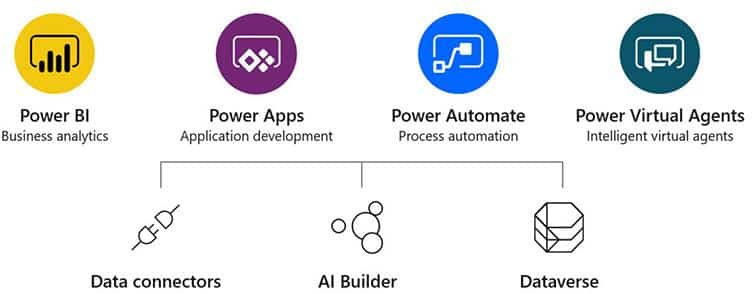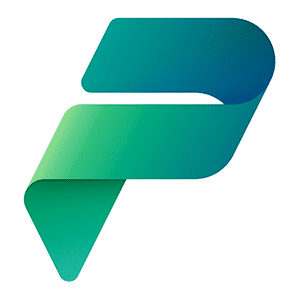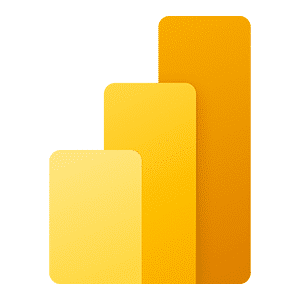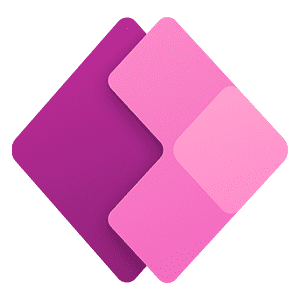What is Power Platform?
How would it sound to create business applications without coding? Or make it easier to run repetitive processes with automated workflows and chatbots? All this and more is possible with the Microsoft Power Platform, and you still don’t necessarily need to write a single line of code.
Commonly referred to as low-code or no-code platforms, Microsoft has taken a firm foothold in this market by developing a great product for citizen coders that makes it easy to develop apps, workflows and reports.
No longer do you need expensive and time-consuming specifications, product development projects and an army of application developers – you can get started with less technical expertise. If you can make presentations in PowerPoint and use formulas in Excel, learning how to make business apps with Power Platform products is effortless.
Power Platform consists of four main products: Power Apps, Power Automate, Power BI and Power Virtual Agents.

Power Apps
Power Apps allows you to quickly produce apps for business needs. Connectors can be used to connect to different data sources (e.g.: Common Data Service, SharePoint, SQL Server). We use numerous apps every day at leisure, so why not use Power Apps in app development for business sore points.
Power Automate
Power Automate’s workflows can be used to automate different stages of the process and eliminate manual activities altogether. Different approval procedures, batch runs, integrations and the same repeated work steps should be left to Power Automate.
Power BI
Power BI enables business information in data warehouses to be analysed and visualised into a format better suited to end users. The distribution of reports has been made versatile by enabling reports to be embedded in other systems or by publishing them directly from the Power BI portal.
DOWNLOAD COMPREHENSIVE GUIDE: HOW TO GET STARTED WITH POWER BI
Power Virtual Agents
Power Virtual Agents on viimeisimpiä tulokkaita Power Platform alustalla. Graafisen suunnitteluvälineen avulla asiakaspalvelu- tai QA-bottien rakentaminen ilman ylimääräisiä koodeja on kaikkien ulottuvilla. Power Platformin jäsenenä Power Virtuals Agents integroituu saumattomasti muihin alustan tuotteisiin ja konnektoreitten avulla taustajärjstelmät ovat kytkettävissä mukaan osaksi prosessia.
How I would utilise Power Platform in my organisation
So there are products for several uses in Power Platform, but then what? It’s still a platform, not so much a finished product. I often find it difficult to unexpectedly come up with areas where Power Platform can help. It’s much easier to listen to the sore points of business and use them to identify solutions to problems.
Rather than start thinking of new applications on the fly, I’d rather take a look at the past and summarise the most typical Power Platform solutions so far (at least in my opinion).
HR apps
There are many processes and practices in HR departments that, unfortunately, are still done manually by circulating paper documents or filling in separate Excel files. The most typical process to be digitalised is the onboarding of a new employee into the company. To this problem I could offer, for example, the following solution.
- Create forms with Power Apps that the supervisor fills in on the new employee.
- Automate the steps of the onboarding process: ordering IDs, obtaining the necessary devices, responsibility for familiarisation, obtaining passes, and so on. Minimum automatic notifications to those responsible for subareas are helpful.
- Track progress of the process from the Power BI report. Which steps have already been done and what is still coming.
- Encourage individuals to do their best with a variety of funny reminders (could that “Your task is overdue” message be replaced by something a bit more cheerful?)
Once an employee has been happily acquainted with the processes and practices of the company, it’s time to start thinking about development discussions, career path, competence mapping and training plan. At all these stages, Power Platform products can be utilised. Collect data using forms and apps made according to processes, store the data in a centralised data warehouse, automate steps with workflows, and create an overall view of the person to a report.
Agile project management with Power Platform
For project management, there are products on the market for just about everyone. Several products suffer from typical problems, it’s hard to find a system that is entirely suitable for the company’s processes. If only it were possible to combine the best features from different products. Instead of building your own Frankenstein’s monster out of different technologies, a LowCode platform like Power Platform can be used to start building your own system in an agile way.
At best, instead of burdensome specifications, business people get to develop an app that meets their own needs with a little training. So what would project management sound like in the familiar Teams interface, where you can automatically create the necessary components for your own Teams groups or channels and set up tools in accordance with your project model for project managers and project portfolio managers to use? All this and more is possible with Power Platform.
How do I get started?
Here are a few examples of typical Power Platform solutions. Often, it is easy to get lost in the form-centric mindset of digitising a form. This is also easy to do, but I challenge you to think of slightly different uses for, say, Power Apps. Could it be used to model the layout of a building and display log data from automation systems? Or use the location data on your mobile device to filter the surrounding area for objects to be audited. Tell us about your ideas.
Sulava helps your organisation utilise Power Platform, from app conceptualisation and implementation of POCs and the actual production application to environment management and maintenance.
Explore our Power Platform courses
-
 PL-900: Microsoft Power Platform Fundamentals790 € (Excl. Tax)
PL-900: Microsoft Power Platform Fundamentals790 € (Excl. Tax) -
 PL-600: Power Platform Solution Architect1790 € (Excl. Tax)
PL-600: Power Platform Solution Architect1790 € (Excl. Tax) -
 PL-400: Microsoft Power Platform Developer1990 € (Excl. Tax)
PL-400: Microsoft Power Platform Developer1990 € (Excl. Tax) -
 PL-300: Microsoft Power BI Data Analyst1790 € (Excl. Tax)
PL-300: Microsoft Power BI Data Analyst1790 € (Excl. Tax) -
 PL-100: Microsoft Power Platform App Maker1790 € (Excl. Tax)
PL-100: Microsoft Power Platform App Maker1790 € (Excl. Tax) -
 PL-200: Microsoft Power Platform Functional Consultant1790 € (Excl. Tax)
PL-200: Microsoft Power Platform Functional Consultant1790 € (Excl. Tax)